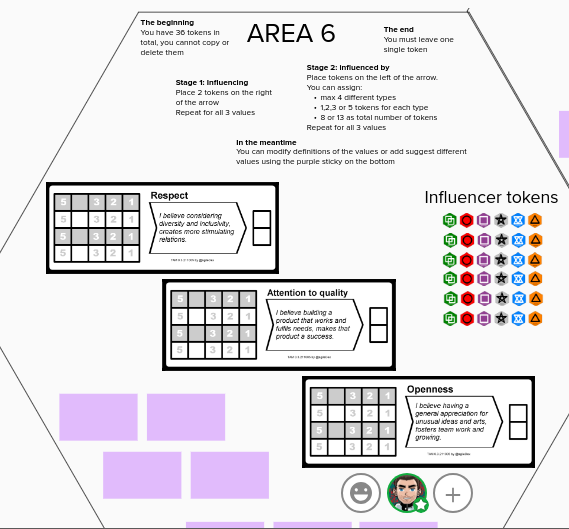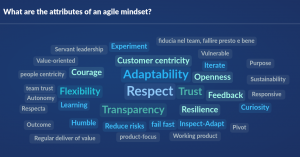
The Agile Mind has been designed as a card game. However the material to create the game, and in particular the “Value>Principle>Practice” chain and the “6 Influencers” provide material for different activities. Also the game actually can be played in different way.
For Agile Tour 2021 I have designed a virtual workshop (than can be easily adapted in person) to introduce the game and to help the teams enter in the same context. The goal of this guide is to help you to facilitate such a session.
In this article you can find the summary of a real session (Agile Tour 2021) that explains in details the dynamic of the session.
Material
In the package of The Agile Mind game available in DriveThruCards portal, you can find also the material for the workshop (images for values and tokens).
I have organised the material in a Mural board, you can find all details in the above linked Agile Tour session here some few notes:
- 6 teams
- 6 area of work distributed in 6 hexagons, and in the middle the 6 Influencers as reference
- 3 values for each team (of different kinds)
- 36 Influencers (6 of each kind) for each team to be distributed across 3 values both as “influencing” and “influenced by”
- stickies to leave some notes
RULE: Influencers are of that given number: you cannot create or delete, but you can exchange with other teams (1:1).
At the end of the session only one must be left unused.
If you are doing this session in person, you can use physical tokens. In the package of the game you can find the material to build your Influencers on hexagonal tokens.
Maybe you can use the Influencer cards 😉
Execution
The session is organised in 2 main stages, with sharing phases at the end of each stage
Stage 1: Influencing (10′)
Teams discuss on “What does the value influence?”
RULE: Place 2 tokens (same or different kind) on the right of the arrow.
Repeat for all 3 values in your area
At the end, each team share what are the values, what these are influencing and why
Stage 2: influenced by (20′)
Teams discuss on “What is the value influenced by?”
Place tokens in the table on the left of the arrow.
RULE: You can assign:
- max 4 different types to each value
- 1,2,3 or 5 tokens for each type
Note the table is arranged to suggest above rules: each row is a kind of Influencer.
Repeat for all 3 values in your area
RULE: total number of tokens can be 13 for the most important value and 8 for other 2
At the end, each team share how and why these values are influenced
Dynamic
The rules are pretty clear to players, however there is always someone asking questions, so it is important during stages move into the breakout rooms.
Stage 1 rules are not critical, but the ones in stage 2 are, because the team can easily meet the limitations imposed by the rules.
One of the most common misunderstanding is in the distribution of tokens into the “influenced by” table of a value.
Here the column of “4” is different to remind you cannot assign 4 influencers of the same type, but when you assign 5 of them you have to place the token also in the 4th column.
One important point is the distribution of the Influencers across values.
Rules are there as a constraint to create a uniform distribution of Influencers (to avoid to use too many of a kind a too few of another kind). However it is pretty common that team has not exactly the amount of influencers of each type they would like to assign to each of the value.
Here is when the exchange rule enters in the game, because this helps to keep the game balance across multiple teams: that is exactly the rule I have used to distribute Influencers in the card game.
However, again, the final outcome is not the distribution of the tokes, but the conversation inside the team.
So in the sharing stage it is absolutely great to tell something like “We put 3 leadership, but we thought it could be better 1 leadership and 2 autonomy“.
Next Steps
In the images available in the package you can find also a “empty” value, this can give you a new possibilities. As a facilitator you can create a session to let team discuss about what are the values of the agile mind. For example I have done this before creating the cards, using a tag cloud and few hundreds of participants to a series of meetups (this is how I have created the set of 18 values in the card game).

When you have a set of values, you can write the values on the empty cards and launch the conversation, again in teams. In this case we have an initial stage
Stage 0: Values (15′)
Teams discuss on “What is the value and why we believe this in important for the agile mindset?”
The team fills the text (in the arrow) describing why they believe this value is important for the Agile Mindset
At the end, each team share the belief for each the values assigned.